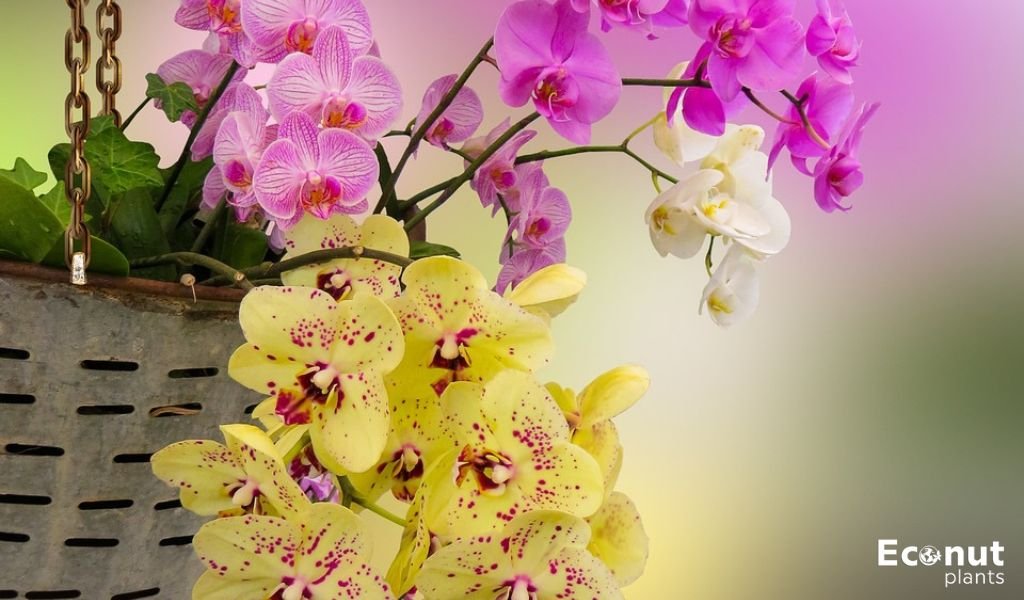Orchids are a special kind of plant when it comes to their ideal growing conditions. For this reason, if you are attempting to grow them somewhere other than their natural habitat, you should be careful.
The good news is that you may find hanging baskets filled with a variety of orchid varieties near their native habitats. This post contains our best advice for gorgeous orchids that are in bloom in hanging baskets!
Choose the Right Variety
It is important to note that while many frequently available orchids are epiphytic; this is not a strict requirement. There are genera of terrestrial orchids, such as those in the family Spathoglottis. Since these plants are ground-dwelling instead of tree-dwelling, their requirements for soil are different.
A hanging basket is not the natural habitat for a terrestrial orchid, which grows on the ground. Though these guidelines are specific to epiphytic orchids, it doesn’t imply you can’t make them work.
For baskets, Cattleya, Phalaenopsis, Oncidium, Vanda, some varieties of Epidendrum, Dendrobium, and a few other less common orchids are good options. Before deciding to place your orchid in a hanging basket, make sure it is an epiphyte.
The right Size and Type of Container
When potting an epiphytic orchid, it’s crucial to choose the appropriate kind of container. Since the roots of these plants are open to the air in their native habitat, they need enough airflow around them.
Two-by-two-inch wooden pieces are joined to create the most common type of orchid hanging basket, which is then positioned in the gaps between the parts on either side. Likewise, the oldest pseudobulb of a potted plant should lean against the container wall to facilitate movement.
Although the plant may eventually grow larger, a monopodial orchid does not require a larger container as frequently as a sympodial orchid. Ascocenda, Vanda, and Phalaenopsis orchids are examples of monopodial orchids.
Find the Right Light
When it comes to their need for light, orchids can be picky. Although they generally prefer filtered or indirect light, some varieties are far more tolerant of direct sunshine than others.
They also enjoy it a great deal. Think about how an orchid clings to a tree’s trunk and branches. The host tree’s branches and foliage block the light that reaches them. The majority of the day should be spent with orchids exposed to bright, indirect light.
While Phalaenopsis orchids cannot withstand direct sunlight as it may burn their leaves, Cattleya, Dendrobium, and Vanda’s like higher light levels than other orchid species.
Keep it Humid
Humidity adores orchids. The roots will likely dry out faster than they would in a ceramic or terracotta pot, so extra humidity is especially needed. Vanda is an exception, as their ideal humidity level is at least 70%. The majority of orchids need the 50% threshold at the very least, while frequent misting will help.
Orchids kept indoors do best when placed in a bathroom window. Using a humidifier to maintain the room’s humidity is an alternative. They had to head indoors as the temperature dropped into the 40s. I place them in my bathroom now that the shower is supplying the required moisture.
Establish a Watering Schedule
Two female hands are shown in close-up, misting and holding a flower in a clay hanging pot in a garden. The orchid features a tall rosette of sword-shaped, glossy, green leaves with smooth edges, as well as a thin, tall stem that supports a blossoming inflorescence of six to eight huge purple flowers. The backdrop garden has a lot of plants in hanging baskets.
One benefit of using a hanging basket is that you can easily view portions of the root system without overly disturbing the plant. Increase the frequency of watering to twice a week if the roots start to seem shrivelled and grey. If they appear brown and mushy, however, reduce the watering and make sure the potting mix dries out in between watering.
Water from the Bottom
If you choose the appropriate container and potting mix, you ought to have good drainage. It is necessary to water a hanging orchid thoroughly because of this. To water from below, fill a washbasin or bucket with water, then submerge the basket for around five minutes.
This approach offers two benefits. It does two things for the plant: it keeps water out of the plant’s crown and allows the plant more time to absorb the water. Similar to root rot in terms of plant health, crown rot can result from leaving water in an orchid’s crown.
Use the Right Potting Media
Only epiphytic orchids—whose potting material requirements are particular—are covered in this session. Start with about 60% charcoal and 20% bark if you want to make your potting medium.
Ordinary potting mix not only creates a mess but also holds a lot of water, which dampens and decomposes in the environment, leaving the roots susceptible to disease. Ordinary potting soils tend to group, which further obstructs airflow around orchid roots.
Fertilize as Needed
Fertilizer is also a huge favourite of orchids. If you properly dilute the fertilizer, they will eat almost all of it. Fertilize them every two weeks during their growing and flowering seasons. Thus, you should fertilize your water bath every other time you water it.
Epsom salt and bone meal are two more fertilizer additions that work wonders for orchids. Watering your orchid once a month with an Epsom salt solution will greatly enhance its bloom.
It gives the plant extra magnesium. By adding bone meal once or twice a year, you can fortify your orchid’s cell walls and increase its resistance to pest damage and fungal infection.
Secure the Orchid
After potting your orchid in its hanging basket, it’s a good idea to keep the plant firmly in place until it has had time to root. The plant will eventually become firmly established in its container when its roots emerge from the potting mix.
Most businesses that sell other potting supplies also have orchid clips available. These clips are used to hold the plant in place; they cover the potting material and stick to the side of the container.
I think floral wire also serves a pretty good purpose. I create a wonderful little web-like structure by slicing a length of wire back and forth across the potting medium.
Conclusion
Following a few simple guidelines will make moving orchids from standing pots to hanging baskets simple. The end product is joyful flowers with gorgeous stalks of blossoms that gently cascade over the edge of the basket. Hiding your orchids is a great way to make room for more plants—even though I hate to say it again!

